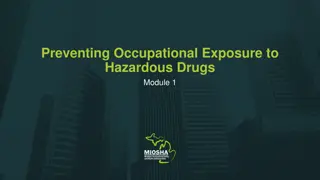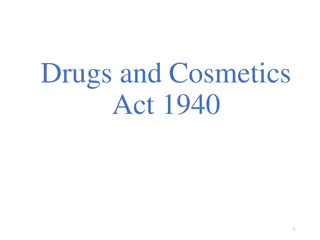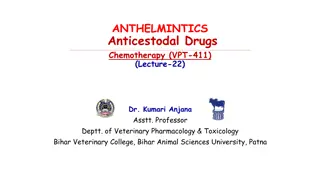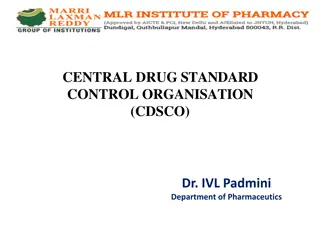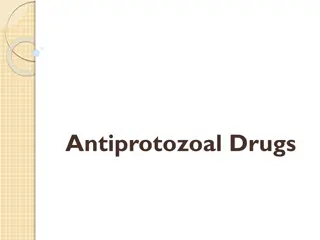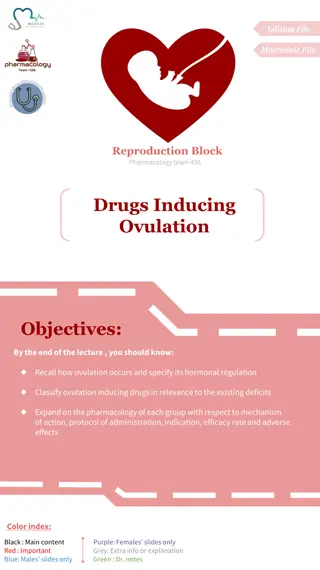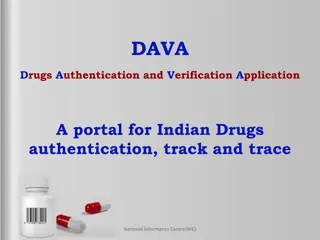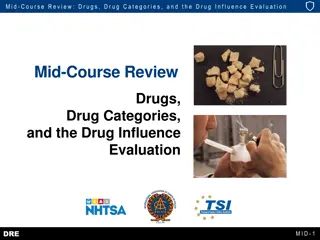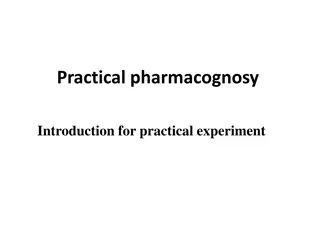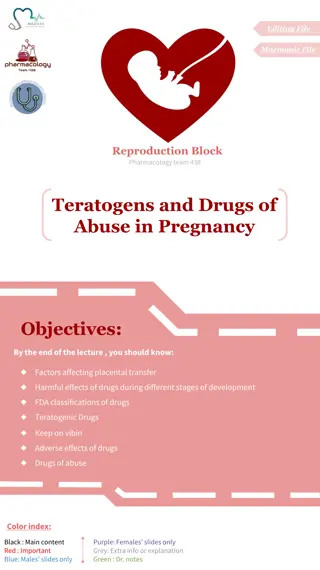
Understanding Emetics and Antiemetics in Gastrointestinal System
Explore the role of emetics and antiemetics in the gastrointestinal system, including their indications, classification, side effects, drug interactions, and nursing responsibilities. Learn about the use of these drugs to induce vomiting, treat poisoning, and manage drug overdose, as well as their contraindications and potential adverse effects.
Download Presentation

Please find below an Image/Link to download the presentation.
The content on the website is provided AS IS for your information and personal use only. It may not be sold, licensed, or shared on other websites without obtaining consent from the author. If you encounter any issues during the download, it is possible that the publisher has removed the file from their server.
You are allowed to download the files provided on this website for personal or commercial use, subject to the condition that they are used lawfully. All files are the property of their respective owners.
The content on the website is provided AS IS for your information and personal use only. It may not be sold, licensed, or shared on other websites without obtaining consent from the author.
E N D
Presentation Transcript
Emetics and Emetics and Antiemetics Antiemetics The GI tract is a lengthy tube through which food travels. It starts at the mouth and ends at the anus. There are many drug groups that operate on the GIT at various levels and exhibit pharmacological and therapeutic activity. Emetics Emesis is a complex response, which is caused by the activation of vomiting center present in medulla oblongata. Drugs that cause emesis are called emetics. They may operate directly on the GI system by causing a local irritating effect on the gastric mucosa.
Indications of emetics To induce vomiting To treat poisoning To treat drug overdose Contraindications Acid or alkali poisoning as it can cause burns of GI tract. CNS stimulant poisoning as these drugs can cause seizures. Kerosene poisoning as it can cause aspiration of kerosene. Unconscious patient a sit can cause aspiration.
Classification of emetics Apomorphine MOA: dopamine agonist ,acts on chemoreceptor trigger zone (CTZ) Dose and ROA: 6mg, IM/SC Side effects: sleepiness, dizziness,sweating, flushing, postural hypotension. Ipecacunaha MOA: acting on chemoreceptor trigger zone, irritating action on intestinal mucosa and cause vomiting within 15-60 min. Dose and ROA:15-30 ml with one full glass of water and given orally.
Side effects/adverse effects Can be unsafe when used for long term or in large amounts.Some of the common side effects includes, Prolonged vomiting Delay of other therapy Dizziness Stomach irritation Feeling sleepy, blurred vision and slurred speech Vagal bradycardia (low HR) Mallory-Weiss tear (tearing of the tissue of the low esophagus, most often caused by violent coughing/vomiting)
Drug interactions Alcohol CNS depressants Activated charcoal Nurses responsibility Always check on the consciousness of the patient Confirm the type of poisoning Do not use emetics if patient have alkali, acid and kerosene poisoning Maintain record of color and amount of vomit and take sample for Lab.investigations. Maintain the intake/output chart of the patient.
Anti Anti- -emetics emetics Drugs that are used to treat nausea and vomiting are called antiemetics. Classification 1.Prokinetic agents 2.H1 antihistamines 3.Anticholinergics 4.Neuroleptics 5. 5-HT3 antagonists 6.Cannabinoids
Classification Dose & Route Class Example MOA Indications Contraindicati ons Drug interactions Side effects 1.Prokinetic agents Domperidone D2 receptor antagonists 10-40 mg Oral Post operative vomiting, drug induced vomiting, disease associated, chemotherapy induced vomiting Hypersensitivity, comatose pattients, Parkinson s disease etc. Olanapine and Metoclopramid e Headache, tachycardia, hypotension, diarrhea,dry mouth,nausea/ vomiting 2.H1 antihistamines Meclozine, Cyclizine Blocks receptors to histamine receptors 12.5-25 mg oral Motion sickness, space motion sickness Hypersensitivity, LRTI,CNS depression, comatose patients, lactating mothers Anti depressants, beta-blockers, arrhythmic drugs, tramadol Confusion, drowsiness,dizz iness, dilated pupils, dry mouth, blurred vision,urinary retension. 3.Anticholinergi cs Scopolamine (Hyoscine) -- 0.2-0.4 mg Oral, 1.5 mg transder mal patch Motion sickness, reduction of secretions before surgery Hypersensitivity, Narrow angle glaucoma, urinary retention, Pregnancy Antidepressant s, Dilated pupils, dry mouth, blurred vision, erythema, difficulty in urination
Class Example MOA Dose & Route Indications Contraindicati ons Drug interactions Side effects 4.Neuroleptics Prochlorperazi ne Block dopamine receptors 5-10 mg Oral, IM, Rectal Vomiting, nausea, intractable hiccups Hypersensitivity, comatose patients, Parkinson s disease -- Postural hypotension, tachycardia, dry mouth, anorexia, urinary retension, constipation 5. 5-HT3 antagonists Ondasetron Blocks serotonin 4-24mg Oral Chemotherapy induced nausea & vomiting, Postoperative and post radiation nausea & vomiting, -- Apomorphine Constipation, diarrhea, headache, feeling dizzy 6.Cannabinoids Dronabinol Antiemetic property 5 - 7.5 mg Oral Chemotherapy induced vomiting, Hypersensitivity, sesame oil hypersensitivity -- Dry mouth, dizziness,euphori a,drowsiness, confusion,anxiety & visual disturbances
Purgatives and Laxatives These are the agents used to stimulate defecation. They soften hard stool, increase volume of stool and facilitate its passage from intestines and evacuation from rectum. They increase bowel movements. Constipation: condition in which a person either has hard stool or some change in bowel movements. Causes Low fiber diet Low fluid intake No physical activity Medications like narcotics Change in routine like pregnancy & travelling Ignoring nature s call Some neurological conditions like stroke & metabolic/endocrine disorders Colon & rectal disorders Chronic idiopathic constipation
Treatment of constipation Diet: high fiber diet, fresh fruits & vegetables Lifestyle changes: plenty of water & fluid intake Laxatives: where diet & lifestyle changes are less effective Indications of laxatives & purgatives Treatment of constipation Irritable bowel syndrome (IBS) Chronic idiopathic constipation Prophylactic use of laxatives in ICU s
Classification Class Example Dose & Route MOA Side effects Bulk forming laxatives Bran, Isaphagula 20-40 g/day, 3-12g/day Absorb water in intestine & increase bulk in intestine Bloating & abd.pain Stimulant laxatives Bisacodyl, Senna 5-15 mg oral tablet , 8.6 mg oral Improve intestinal secretions & motility Abd.cramps,dehydratio n,allergic reactions Osmotic laxatives Lactulose 10-20 mg oral Draws water into intestinal lumen Bloating,nausea,vomiti ng & diarrhea Stool softeners Liquid paraffin 15-30 ml Oral Moistens stool & prevent dehydration -- Lubricants Mineral oil 45 ml in single/divided doses Oral & Rectal Grease stool, easy bowel movement Aspiration & lobar pneumonia Saline laxatives Milk of Magnesia -- Draw water into colon for easier passage of stool Bloating, vomiting, abd.pain, headache Chloride channel activators Lubiprostone, amitiza -- -- Diarrhea, nausea, headache
Role of nurse Advise the patient to consume more fiber diet Advise to maintain good bowel habits Advise to take one full glass of juice or water with bulk forming laxatives Advise to modify habits,dietary changes, exercise for proper bowel pattern. Advise not to consume Castrol oil late night Advise to take more fluids while consuming osmotic laxatives Long term use of laxatives to be avoided as it can cause decrease in bowel tone
Antacids These are group of chemicals that contain different salts of calcium, magnesium and aluminium as active components. These are weak bases that neutralize acid in stomach. These also inhibit formation of pepsin. These agents help to raise ph of stomach. Indications Heartburn Duodenal and gastric ulcers Stress gastritis Pancreatic insufficiency Non-ulcer dyspepsia Diarrhea caused by bile acid Biliary reflux Constipation Osteoporosis Urinary alkanization Chronic renal failure
Hydroxyaluminium hydroxide 640mg taken daily after meals at bedtime for 5-6 times/day Carbonate of calcium It is taken upto a maximum daily dose of 8000 mg upto two weeks for symptomatic relief Hyperphosphatemia Total dose is not to exceed 2000mg/day Duration of action Antacids acts within 30 minutes when taken on empty stomach and takes 2 hours when taken after a meal.
Adverse effects Constipation Diarrhea Encephalopathy in renal failure patients Nausea, vomiting, abdominal cramps Contraindications Hypersensitivity Renal failure, heart failure, edema Cirrhosis, GI hemorrhages, renal calculi Role of nurse Periodic monitoring of calcium and phosphorus plasma concentrations is a suggested practice in patients on chronic therapy.
Antipeptic ulcer drugs Gastric ulcers are erosions present in stomach, esophagus and duodenum. Drugs that are used to treat gastric ulcers are called anti-peptic ulcer drugs. Classification Histamine blockers Proton pump inhibitors Anticholinergic drugs Ulcer protective drugs Prostaglandin E1 analog
Class Example Dose & route MOA Indications Contraindicati ons Adverse effects 1. Histamine blockers Ranitidine 150-300 mg Oral/IV/IM Decrease gastric acid secretion GERD, Intestinal hemorrhage -- Abd.cramps, jaundice, diarrhea, headache, lethargy, confusion, Rash, sweating 2. Proton pump inhibitors Omeprazole 20-40 mg Oral/IV Antiulcer therapy Esophagitis, peptic ulcer disease Hypersensitivity, severe hepatic disease abd,.pain, nausea, anorexia, diarrhea, headache, dry skin, cough, fatigue, anemia 3.Anticholinergi c drugs Pirenzepine, Telenzepine -- Decrease GI secretions, acid, pepsin and mucus in stomach and delay gastric emptying Motion sickness, nausea and vomiting or perioperative period Rarely cause liver injury Dry mouth & eyes, hyperthermia, headache, visual blurring, constipation, urinary retension, tachycardia & palpitations
Class Example Dose & route MOA Indications Contraindicatio ns Adverse effects 4.Ulcer protective drugs Sucralfate 1 gram given 1 hour before meal and at bedtime Viscous gel that adheres to ulcer creator. GERD, Gastritis, Peptic ulcer disease, Stress ulcer, Chronic peptic ulcer disease, duodenal ulcer End stage renal disease, uncontrolled diabetes, impaired swallowing/ gag reflex Blue lips & fingernails, difficulty in swallowing, feeling of fullness, dry skin, increased thirst 5.Prostagland in E1 analog Misoprostol 100-200 mg orally 4 times in a day with meals & bedtime Suppresses secretion of acid in stomach Prevention & treatment of NSAID associated gastric ulcer, peptic ulcer Pregnancy, child bearing age females Abd.pain, diarrhea, dysmenorrhea and spotting may occur in some females.
Role of a nurse Advice to take regular meals (5-6 meals) and reduce stress to enhance therapeutic effects Advice to avoid alcohol, smoking & caffeine Advice to observe side-effects Advice to avoid heavy meals at least 2 hrs before bedtime Advice to consume less spices Advise to take antacids 1-3 hrs after meals and at bedtime Antacids should be chewed properly and after that water or milk should be consumed
Anti diarrheal drugs These are the drugs used to treat diarrhea. Classification Anti-motility agents Anticholinergic/antispasmodic drugs Adsorbents Other anti-diarrhoel agents
Class Example Dose & route MOA Indications Contraindications Adverse effects Anti-motility agents Loperamide 4 mg followed by 2 mg after each motion Anticholinergic effect at acetylcholine receptor sites Relieves GI muscular spasms, IBS, stomach & intestinal cramping Glaucoma, cardiovascular instability, toxic megacolon Dry mouth, dry eyes, blurred vision,confusion, constipation, headache, nervousness, drowsiness Anticholinergic Mesalazine 1.5-4 g daily Decrease muscle tone of intestine & reduce peristaltic movements Ulcerative colitis, traveler s diarrhea, drug induced diarrhea hypersensitivity Urinary retension, headache, confusion, dry mouth, blurred vision Adsorbents Isapagula, Psyllium, Methyl cellulose -- Bind with bacteria that cause diarrhea & stool becomes firm and less watery IBS, ileostomy, colostomy -- Constipation, Flatulence Intestinal flora modifiers Lactobacillus (sporolac) 100 mg 4 times daily for 2-5 days Tablet/powder form Effective against gram negative bacilli Cholera, Giardiasis Infants < 1 month, Alcohol Convulsions, tremors etc.
Fluid and Electrolyte therapy Fluid and electrolyte therapy is crucial in managing diarrhea, particularly to prevent dehydration and restore electrolyte balance. 1. Importance of Fluid and Electrolyte Replacement Dehydration Risk: Diarrhea can lead to significant fluid and electrolyte loss, particularly in children and the elderly, increasing the risk of dehydration. Symptoms of Dehydration: Thirst, dry mouth, decreased urine output, dizziness, rapid heartbeat, and lethargy.
2. Types of Fluid Replacement Oral Rehydration Solutions (ORS) Composition: ORS typically contains water, glucose, sodium, and potassium. The WHO-recommended ORS formula has: Sodium: 75 mEq/L Glucose: 75 mmol/L Potassium: 20 mEq/L Citrate: for alkalinizing effect (optional) Administration: Start with small, frequent sips, especially for children. Adults can drink larger volumes but should aim for about 1 liter of ORS for every 3-4 loose stools.
Intravenous (IV) Therapy Indications: Used when oral rehydration is not possible (e.g., severe dehydration, persistent vomiting). Solutions: Common IV fluids include: Isotonic solutions (e.g., Normal Saline, Lactated Ringer s). Balanced electrolyte solutions. Administration: Typically in a healthcare setting, with dosages tailored to the patient's needs. 3. Electrolyte Replacement Key Electrolytes: Sodium: Essential for fluid balance and nerve function. Potassium: Vital for muscle and nerve function; often lost in diarrhea. Chloride and Bicarbonate: Important for acid-base balance. Monitoring: Regular monitoring of electrolyte levels is essential, especially in severe cases. Blood tests may be necessary to assess levels.
4. Considerations Age and Severity: Children and elderly patients are at higher risk of dehydration and may need more aggressive rehydration strategies. Underlying Conditions: Individuals with pre-existing health conditions (e.g., heart disease, kidney disease) may require fluid and electrolyte management. Diet: Once rehydration is underway, a return to a normal diet (with easily digestible foods) is encouraged as tolerated. 5. Signs of Improvement Increased urine output, improved energy levels and resolution of thirst and dry mouth are positive signs indicating effective rehydration.
There are some drugs used to treat Diarrhea 1.Furazolidone Mechanism of Action (MOA) Antimicrobial Activity: Furazolidone works by inhibiting bacterial enzyme systems, leading to the disruption of nucleic acid synthesis and cell metabolism. It s effective against a range of Gram-positive and Gram- negative bacteria as well as some protozoa (e.g., Giardia lamblia). Indications Gastrointestinal Infections: Often used for treating diarrhea caused by bacteria, particularly in cases of enteritis and foodborne illnesses. Protozoal Infections: Used in the treatment of infections like giardiasis and some cases of amoebiasis. Dosage: 100 mg taken orally four times daily for 7 to 10 days.
Side Effects Common Side Effects: Nausea and vomiting Abdominal pain Loss of appetite Serious Side Effects: Allergic reactions (rash, itching, swelling) Peripheral neuropathy (rare) Hemolytic anemia (especially in individuals with G6PD deficiency) Drug Interactions: Furazolidone can interact with monoamine oxidase inhibitors (MAOIs), leading to hypertensive crises. Caution is advised with other medications that affect serotonin levels, as furazolidone can cause serotonin syndrome.




